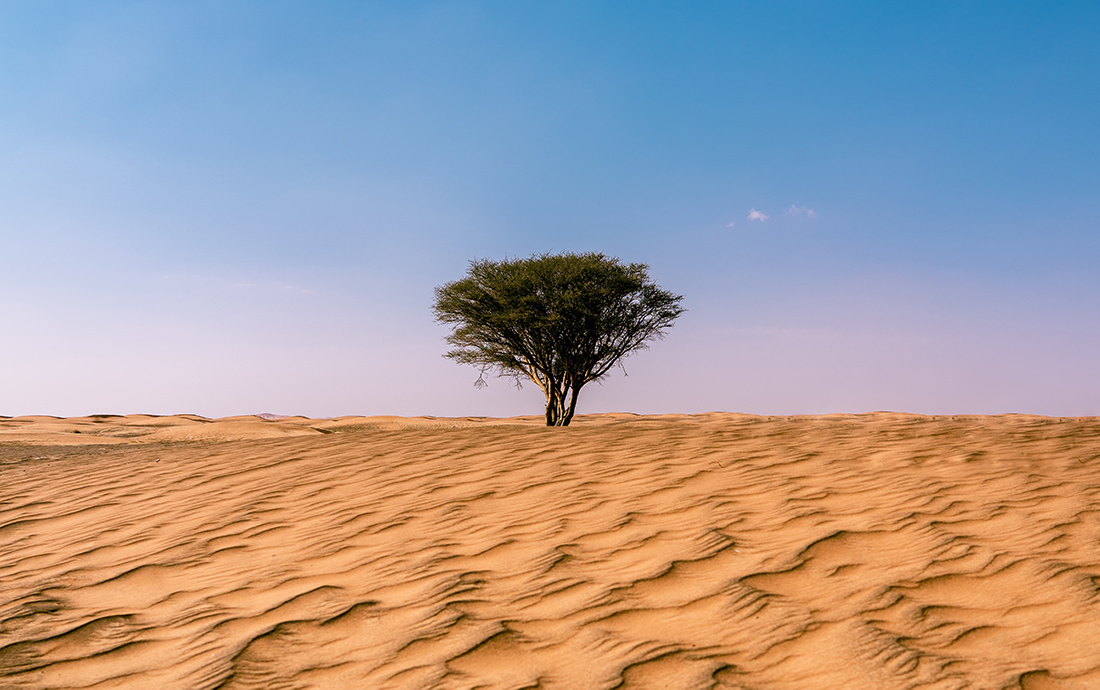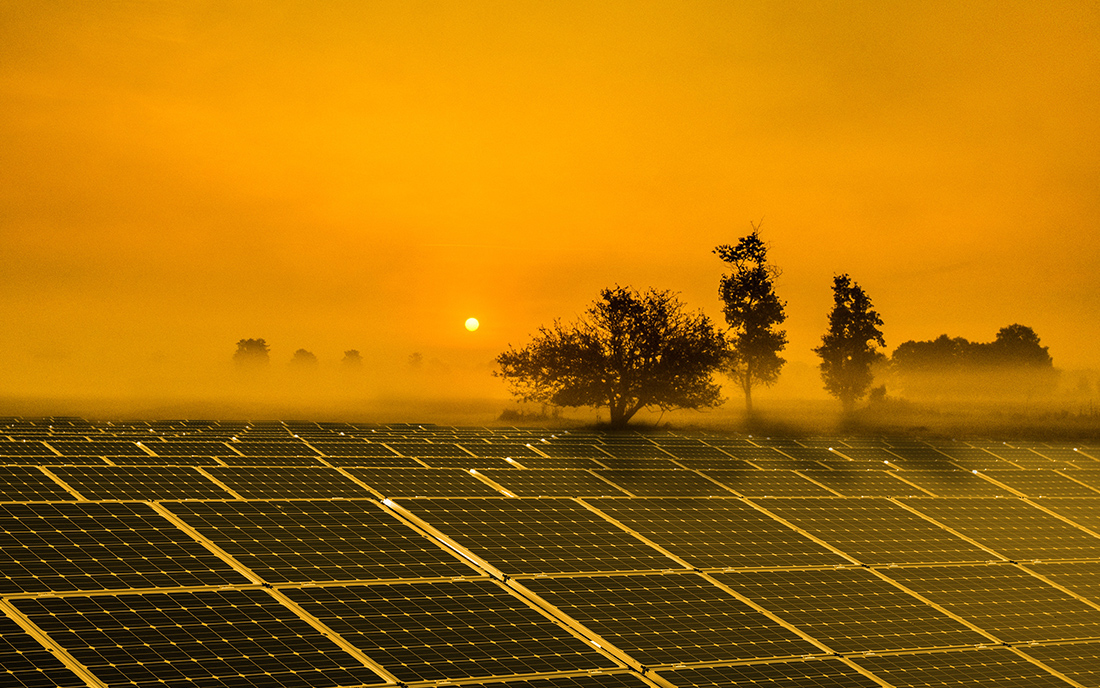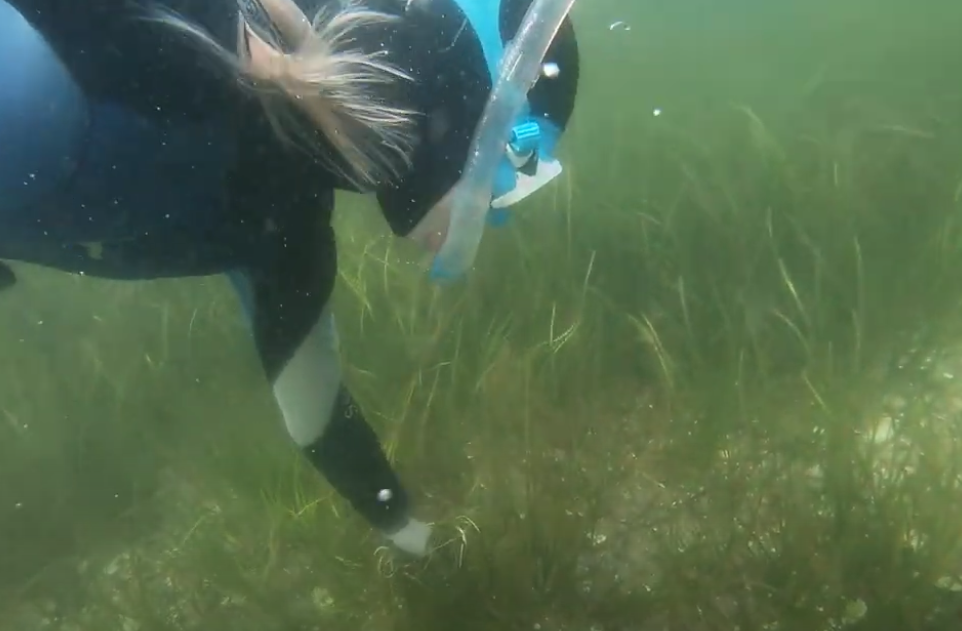Green deserts: How solar energy can help produce water

There are forward-looking ideas for countries suffering from persistent water shortages. Various initiatives are addressing the problem of water scarcity in very different ways and are successfully seeking innovative solutions. Cosmotaics, for example, is developing solar parks for desert areas that simultaneously produce water via condensation.
More than a third of the earth’s surface is dryland. The annual precipitation here is less than the potential evaporation. This means that rivers dry up before they reach the sea. Climate change is likely to exacerbate water scarcity in the future, as natural resources become increasingly scarce. In addition to (potable) water, there is often a lack of electricity for pumps and agricultural equipment. However, water and power lines can hardly be laid in the sometimes very remote regions. In the case of electricity generation, a decentralized solution is now easily possible thanks to photovoltaic systems. For water production, unconventional methods could be the solution. It is precisely these arid regions that the Cosmotaics team has its sights set on. Students Igor Luketina, Juan Carrion and Marcin Las from Vienna are completely rethinking photovoltaic systems for arid regions. What if there was a way to produce water on the spot and make this area green again? Their answer: solar parks become water farms!
How the sun can help harvest water in the desert
Cosmotaics wants to set up special solar parks in desert areas. The plants designed by the Vienna-based company extract moisture from the ambient air, which condenses on the specially shaped and coated construction elements. This is achieved with the help of special plates called “cosmotaics. With simple solar collectors, it would not only be possible to generate electricity, but also to collect water. Water is stored on the opposite side of the solar modules – passively, without energy consumption. The larger the panel surface, the more efficient the system. The collected water is used to irrigate the soil and roots, and in addition, water can be provided for communities living in the surrounding area and for agricultural purposes. Another positive effect is that the solar panels can be cleaned of desert dust with the water, which increases their efficiency. The underlying idea has so far only been used in mountainous regions, where so-called fog nets on mountain ridges collect water from the passing air. The idea is new for large-scale systems in flat strips of desert where conditions are ideal for generating solar power. The potential is immense: if the cultivation of agricultural products succeeds, this will enable and secure a livelihood for the local people and make it easier to live (or survive) in extreme arid regions.
“Cosmotaics is dedicated to producing clean energy and protecting our environment. Our solar parks generate renewable energy by harnessing the power of the sun. In doing so, we aim to help reduce CO2 emissions and decrease dependence on fossil fuels.” – Founder of Cosmotaics, Igor Luketina
The idea for the project came to Luketina on the coast of Ecuador when he lived there for two years and water scarcity was a constant companion. With their holistic approach, the team was able to win the Social Impact Award (SIA) Austria (SIA) Austria in 2022. The goal is to restore drought-stricken areas worldwide due to rising temperatures. In addition to energy efficiency, Cosmotaics’ solar farms would also contribute to a cooler environment. It remains to mention that plants in the desert could sequester huge amounts of CO2. A prototype is currently being built in Austria and perhaps green deserts, the dream of many generations, will then eventually come true.
Forward-looking ideas for countries suffering from constant water shortages
There are some projects and start-ups that specialize in water harvesting in extremely dry areas:

Munich Re Foundation – Extracting drinking water from fog
Fog nets provide access to sufficient drinking water supplies even in dry and hard-to-reach regions. The principle of “fog harvesting” is simple, but extremely effective in regions with high levels of fog: wind pushes the moist air through the nets of the installed collectors. The fog condenses, and small drops of water flow from the netting into collection troughs that are directly connected to cisterns and the water supply system. The condensed mist is of drinking water quality, improving the quality of life of vulnerable people.

University of California in Berkeley – Water vapor from dry air
Examples from flora and fauna show the way: They extract water from their ambient air. Animals and plants adapted to desert climates benefit from the fact that the air still contains moisture even in these dry environments – as water vapor or mist. Scientists have developed a process to extract liquid water from desert air. The system absorbs water vapor even at low humidity levels and allows the water to condense. What’s special about it is that this method works without an additional power supply – the drive comes solely from the changing solar radiation of day and night.

King Abdullah University of Science and Technology (KAUST) – Solar cells with hydrogel generate electricity and water in the desert
In Saudi Arabia, a system consisting of two components is being developed, connected by a hydrogel. The polymer backbone of the hydrogel consists of the salt calcium chloride and the organic compound polyacrylamide. In combination, these materials can bind large amounts of water. Moreover, the hydrogel attracts water even at low humidity levels. During cool desert nights, the hydrogel binds water from the air. During the day, the hydrogel releases water due to the heat of the sun and the panels of the solar system.

ETH Zurich – Drinking water from the air
The system at ETH Zurich demonstrates that water can be extracted cleanly from the atmosphere without the need for an additional energy source. To do this, water is collected in a shiny silver, cone-shaped funnel. This is done by means of a multi-coated glass pane with a diameter of less than ten centimeters, on which moist air condenses. The good thing is that the system is inexpensive and low-tech. However, it takes up a lot of space and only works at a humidity of more than 65 percent, and the amount of water recovered per system is also rather manageable.
Why is it important for drylands like deserts to become viable again?
Drylands are an important part of our global ecosystem and have both ecological and socio-economic importance.
- Biodiversity: Drylands are home to many rare and endangered species that can only survive in these areas. When drylands are viable, these species can survive and their ecosystems can recover.
- Climate change: Drylands are particularly vulnerable to climate change because they are already affected by water and precipitation shortages. By restoring drylands, we can help combat climate change and reduce the impact on local communities.
- Water resources: Drylands are often the source of important water resources that are vital to local agriculture and drinking water supplies for the population. When drylands are viable, they can stabilize and ensure these water resources.
- Socioeconomic: Drylands are often home to poor and marginalized populations that depend on agriculture and natural resource use. Policies for stable and viable drylands can improve the quality of life for these populations and increase their resilience to environmental change.
- Ecological balance: Drylands have an important role in ecological balance and also influence climate and water supply in neighboring areas. Therefore, it is important to restore the functioning of deserts to maintain ecological balance.
There are several ways to revegetate deserts.
- Reforestation: planting trees and shrubs in desert areas to prevent soil erosion and improve the soil.
- Rainwater harvesting: collecting rainwater to use later for watering plants.
- Sand dune stabilization: Using techniques to stabilize sand dunes with mulch, rocks, and plants to prevent severe sand drift.
- Revitalizing oases: The revitalization of natural oases through the use of water, plants, and animals.
- Biomass energy: the use of plants grown in desert areas to produce biomass energy.
- Agroforestry: The use of trees and shrubs in combination with agricultural crops to improve soil and provide water and shade.

Cosmotaics
We support Cosmotaics in February 2023 with the proceeds from GOOD. You can find out more about this on our project page:
Fragen, Kritik, Anregungen? Schreibt uns!
Andreas Renner, Co-Founder GOOD: andreas@good-search.org

